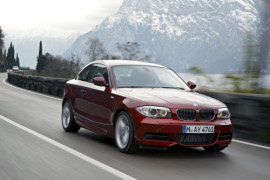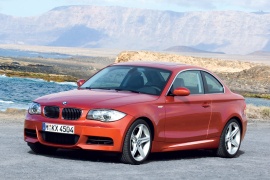BMW 1 Series Coupe Models/Series Timeline, Specifications & Photos
First production year: 2007
Engines: Diesel, Gasoline
Body style: Coupé (two-door)
The sporty two-doors had a controversial exterior design with inspiration drew from the iconic BMW 2002, with sculpted sporty lines and dominating panels.
Sharing most of its mechanical components with the 3-Series, that Series 1 offered a precise handling and great ride comfort.
The Series 1 coupe was available in two trim levels, the 128i and the 135i.
Standard equipment offered with the 128i included 17-inch alloys, automatic headlights, rain-sensing wipers, automatic headlights, a leather-wrapped steering wheel and a 10-speaker audio system.
The 128i equipped with Series 1 with a 3.0-liter 6-cylinder engine that produced 230 hp and 200 pound-feet of torque.
Stepping up to the 135i trim level, the standard equipment included a tweaked suspension, 18-inch alloys, a sunroof, xenon headlights and automatic climate control, besides the features of the 128i.
Numerous optional packages were available for both trim levels, adding sport seats, a sport suspension, upgraded interior trim, mood lighting, Bluetooth connectivity, leather upholstery, a navigation system, a premium audio system, rear parking assist and heated front seats.
The 135i trim level offered a more powerful unit, a 3.0-liter 6-cylinder that cranked out 300 hp and 300 lb.-ft of torque.
Safety wise, standard equipment included antilock disc brakes, traction control, stability control, front-seat side airbags and full-length side curtain airbags.
BMW 1 Series Coupe (E82) 120i 6AT RWD (170 HP)
BMW 1 Series Coupe (E82) 120i 6MT RWD (170 HP)
BMW 1 Series Coupe (E82) 125i 6AT RWD (218 HP)
BMW 1 Series Coupe (E82) 125i 6MT RWD (218 HP)
BMW 1 Series Coupe (E82) 128i 6AT RWD (230 HP)
BMW 1 Series Coupe (E82) 128i 6MT RWD (230 HP)
BMW 1 Series Coupe (E82) 135i 6MT RWD (306 HP)
BMW 1 Series Coupe (E82) 135i 7AT RWD (306 HP)
In 2007, BMW made a surprising move and introduced a smaller vehicle than the 3 Series when it launched the 1 Series, which became the only premium coupe in the small-sized segment.
When the German automaker launched the first generation of the 3 Series in 1975, that model became an instant hit thanks to its low price, good performance for top versions, and fuel efficiency for the lower-powered ones. That success continued with the second generation, the E30, that followed in 1982. But all these new generations grew up in sizes and prices. As a result, young customers couldn’t afford them anymore. To gain its newer audience back, BMW made the 1 Series an affordable vehicle. Furthermore, besides the three- and five-door hatchback versions, the automaker also offered it as a two-door coupe, also known as the E87.
Maybe it wasn’t the best-designed BMW ever, but the E87 impressed its customers with its front fascia. The automaker offered it with either a standard or an M-package look. Still, both shared the same organic-shaped headlights that resembled those from its bigger sibling, the 3 Series. While the lower grade got a simple bumper with an apron that sported a rectangular lower grille flanked by a pair of scoops that housed the fog lamps, the M-package version featured a trapezoidal center air intake and a lip spoiler underneath the bumper.
The car’s profile revealed a raked windshield followed by an arched greenhouse that ended into a sloped down rear window onto the short deck. Its frameless doors and fixed rear windows resembled the lines of the first generation of the 3 Series. Depending on the trim level, the car sported aerodynamic side skirts and large wheels, while at the back, a duck-tail adorned the trunk. Furthermore, the rear bumper featured a lower-mounted diffuser with single or double side exhausts, depending on the engine version.
Inside, BMW offered the vehicle in a few grades, with either comfort or M sports seats for the front passengers. The driver fronted a narrow instrument cluster where the speedometer and tachometer took most of the area, including the fuel level and engine temperature gauges at their bottom. Base versions featured single-zone manual air-conditioning, while top versions provided dual-zone automatic climate controls. The 1 Series could also be optioned with a retractable screen for an infotainment system, which folded onto the dashboard’s top. In the back, there was hardly any room for adult-size passengers, but those two seats could still be used for short distances.
Under the hood, BMW installed a wide choice of diesel and gasoline engines ranging between 143 PS (141 hp) and 306 PS (302 PS). Power went to the rear wheels via either a six-speed manual or a six-speed automatic, depending on the option.

